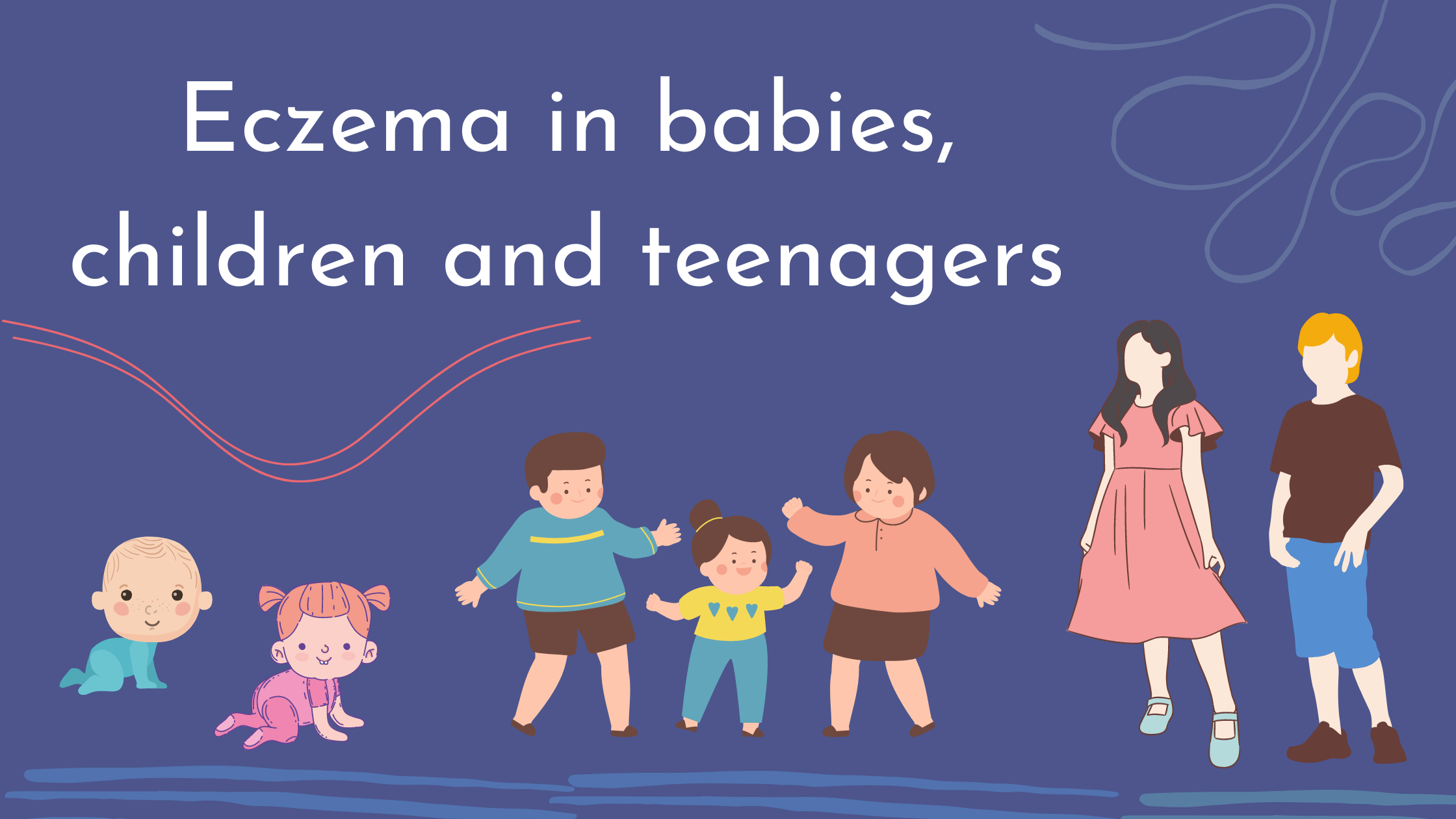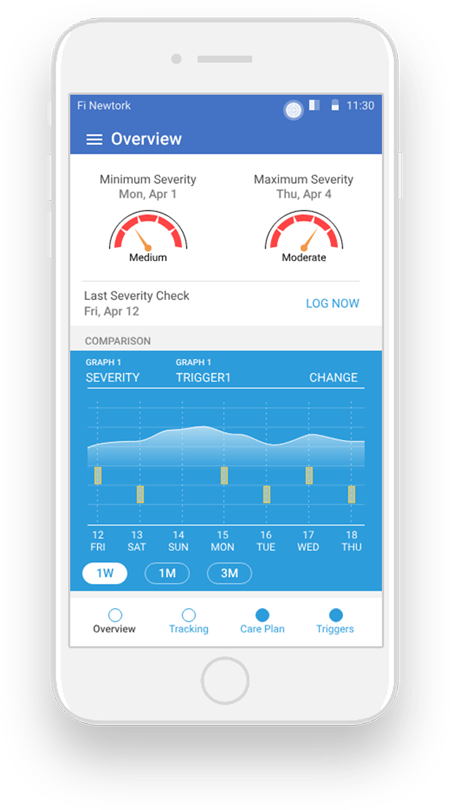Eczema in babies, children and teenagers

Table of contents
- Introduction
- Why do children develop eczema?
- Eczema in various age groups
- When should you take your child to a doctor or a dermatologist?
- How is eczema in a child treated?
- What can you do to help your child with self- care?
- Summary
Introduction
Eczema is a common chronic skin condition that makes the skin inflamed, red and itchy. There are several types of eczema affecting all age groups. Infants and children commonly get atopic dermatitis and seborrheic dermatitis. Eczema, especially atopic dermatitis often appears in the first 6 months to 5 years of a child’s life. Eczema affects up to 25% of children worldwide. It is estimated that 60% of people with eczema develop it during the 1st year of their life. Eczema, commonly atopic dermatitis may change on how it looks and acts as your child grows older.
Often Eczema have various age groups. Eczema in a child can be treated accordingly.
As parents of children affected with eczema, it is good to know the following facts for better understanding of this skin condition;
- Eczema is not contagious. Therefore, your child cannot ‘catch it’ from someone or give it to another.
- It is better to identify the particular triggers that causes flare ups in your child in order to prevent exposure and a subsequent flare. Common triggers include; irritants like soap and detergents, allergens like dust mite and animal dander, overheating, various irritant fabrics like coarse fibered wool, stress, food allergies, bacterial and viral infections etc.
- Implement a daily bathing routine and proper moisturizing to protect your child’s skin and to lock in the moisture.
- You have to use prescription medication consistently to control symptoms.
- There is no cure for eczema and it can be controlled only.
- Discuss with your dermatologist and get a proper diagnosis of the type of eczema that your child has. So that it will be easy to manage symptoms and flares while preventing further flares by avoiding triggers.
- It is helpful to maintain a diary on your child’s eczema flare ups and possible triggers that led to them.
Why do children develop eczema?
The exact cause of eczema is unknown. Children who develop eczema has a combination of genes and environmental triggers. Something outside the body (extrinsic triggers) or something within the body (intrinsic triggers) may switch on the immune system leading to an eczema flare. Children who come from eczema families (families with a history of atopic triad – eczema, asthma or hay fever) has an increased tendency to develop atopic dermatitis.
Eczema in various age groups
Eczema looks and acts differently in children of various age groups. The appearance of eczema and the location in the body the rash appears, change as your child grows.
Below mentioned are Eczema age groups:
Eczema in infants (1st 6 months)
Eczema usually appear on your baby’s face, especially cheeks, chin, forehead and scalp. Scalp eczema is mainly due to seborrheic dermatitis which is commonly known as the cradle cap. The eczema in face can spread to other areas of the body.When seborrheic dermatitis affects the diaper region in the body, the area becomes red and inflamed. Eczematous skin in infants, tends to look more red and weepy.
Eczema in babies (6 – 12 months)
Eczema often appears on your baby’s knees and elbows rather than the face. Because these are places that are easy to rub as they crawl and easy to scratch. The eczema rash can get infected. Then there will be pustules (small pus filled bumps) or form a yellow crust on the skin. Babies with nappy rash may have seborrheic dermatitis in their nappy region.
Eczema in toddlers (2- 5 years)
Atopic dermatitis commonly occur in elbow creases and knees. Your toddler’s hands, wrists and ankles can get affected too. Frequently the face is affected. Red patches with small bumps may appear on your toddler’s face – around the mouth and the eye lids. Your toddler’s skin may look dry and scaly. Toddlers and preschoolers commonly have patchy eczema on their elbows, wrists, knees and ankles. Sometimes lichenification (thick lesions with deeper lines) can occur due to scratching.
Eczema in children (5 – 12years)
Eczema usually appears in the back of elbows and knees. Sometimes hand eczema can be common. Itchy patches and redness may develop behind your child’s ears, scalp and feet.
Eczema in teenagers
Teenagers can have patches of eczema anywhere on their bodies. These areas include; around their necks, eye lids, ears, hands, folds of their elbows and behind their knees. These patches can be inflamed, thickened and bumpy. Lichenification can occur because of frequent scratching.
Track and Manage your Eczema treatment using a comprehensive Eczema App
Download Eczemaless now
When should you take your child to a doctor or a dermatologist?
- If your child developed the rash for the first time and if you are not sure whether it is eczema
- If the eczema is very itchy and your child scratches uncontrollably
- If the lesions are oozing (weeping) or bleeding
- If your child has trouble sleeping because it is so itchy
- If the eczema does not respond after a few days, although you have been treating as usual
- If the rash is painful
- If there is pus oozing from the lesions or pustules (pus filled bumps) formed on the lesions
- If your child is having fever, feeling tired and ill
How is eczema in a child treated?
Eczema in a child is not curable. It is managed by treating flare ups as they appear and preventing future flares. If your child’s eczema is mild, local application of a mild corticosteroid cream or ointment will help to control the lesions. Ex: 1% hydrocortisone. This can be bought over the counter as well.
If your child’s eczema is severe, you will need a prescription for a stronger corticosteroid. For children with mild to moderate eczema on face and body folds, a non – steroidal cream like pimecrolimus or tacrolimus may be prescribed.
Antihistamines like cetirizine or fexofenadine are prescribed to reduce itching and to prevent your child from scratching the rash. Scratching can worsen an eczema rash. Corticosteroids and antihistamines will settle the flare within a few days in many children. An oral steroid course will be prescribed for children with severe eczema. Oral antibiotics will be prescribed if your child’s rash is infected, when pus is present or if your child has fever because of the infected rash.
What can you do to help your child with self- care?
As parents you have a big role to play in ‘at home treatment’ of eczema.
- Get your child to use a moisturizer regularly. A good, thick moisturizer which is fragrance free is ideal to use twice a day. Your child can apply the moisturizer soon after a bath or shower, while the skin is still damp. It will help to absorb the moisturizer in to skin well. For babies and younger children, it is your duty as parents to keep them well moisturized.
If your child’s skin is very dry, ointments are better as they are greasier than creams.
- Bathing routines – Make sure that your child have short baths or showers. Water can be lukewarm but not hot, because hot water can strip the moisture from the skin. A simple fragrance free moisturizing bath oil is better than using soap or body wash.
Bathing helps to get rid of dirt and other irritants from your child’s skin. When bathing your baby, wash your baby’s smelly and dirty body parts using a mild fragrance free cleanser. Avoid scrubbing your baby’s skin. Limit the bath time to 5-10 minutes. Apply moisturizer soon afterwards.
- Keep your child cool. Avoid keeping them near heaters or fire places.
- Avoid dressing them with too many layers of clothing. Cotton clothes and underwear are better. Avoid clothes made with polyester and coarse fibered wool.
- If your child scratches often, try to distract them. Keep their finger nails short and clean. You can put cotton mittens to cover your baby’s hands.
- Identify and avoid triggers and allergens that can irritate their skin.
It is important to start treating your child’s eczema as soon as you notice it. This can prevent the skin condition from worsening. Delayed seeking of treatment makes it more difficult to treat and control eczema.
Children with eczema become more prone to skin infections. Eczema further weakens the skin barrier making it easier for viruses, bacteria and other germs to get inside the body. If you notice any skin infection on your child such as sores, yellowish crusts on skin or pus filled blisters seek help without delay.
Summary
Eczema is a common chronic skin condition which has no cure. It is quite common in babies, children and teenagers. Eczema can be controlled with a customized skin care routine. This includes moisturizers, prescription medications and eliminating triggers to prevent future flare ups. As parents and caregivers you have a big role to play when it comes to managing your child’s eczema.
References:
https://nationaleczema.org/eczema/children/
https://www.aad.org/public/diseases/eczema/childhood/treating/treat-babies
GET IN CONTROL OF YOUR ECZEMA
Use our AI tool to check the severity of Eczema and keep track of your Eczema progress.



